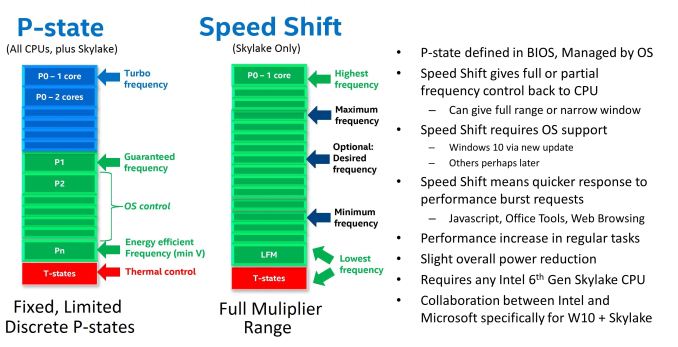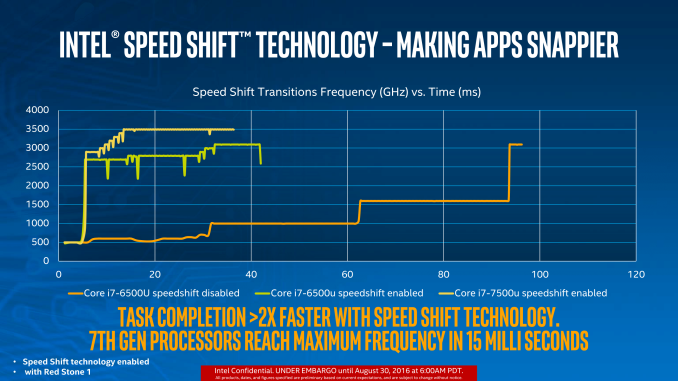The Intel Core i3-7350K (60W) Review: Almost a Core i7-2600K
by Ian Cutress on February 3, 2017 8:00 AM EST7th Generation New Features
One of the big questions regarding the launch of Intel’s 7th Generation of CPUs was around what extra features the new platform brings, especially if there isn’t any clock-for-clock performance improvement. As with our other Kaby Lake reviews, here we explain the main two: Speed Shift v2 and Optane Memory support.
Speed Shift v2
For the Intel’s 6th Generation of processors, Skylake, they introduced Speed Shift (v1). This was a feature that, at a high level, gave control of the voltage/frequency curve from the operating system to the processor. Using a series of internal metrics, such as instruction analysis and frequency, the CPU would automatically adjust the voltage and frequency of the processor as required. This afforded two major benefits: one, with the CPU in control it has access to many more points on the curve compared to the OS which is limited to specific P-states on the processor.
The second benefit is the speed of transition. A processor that can ramp up to a high frequency quickly and then drop down as needed can get through instructions quicker but also save power. Imagine driving a car, and having to wait 60 seconds to change a gear – it’s that sort of analogy.
What Speed Shift v2 does in the Kaby Lake family, compared to v1 in Skylake, is manage those transitions to higher frequency faster. Before Speed Shift, transitions from idle to peak turbo were on the order of 100 milliseconds, and Speed Shift v1 took that to 30 milliseconds (with a good base established within 15). Speed Shift v2 means that peak performance from idle now happens in 10-15 milliseconds total. This means that interactions with the OS, such as touch, or actions that rely on low latency, can occur within a couple of frames on a 60 Hz display.
The benefit of Speed Shift lies a lot in touch devices, which perhaps doesn’t affect the desktop Kaby Lake processors in this review, but also in web interactions. A lot of web work is stop and start, such as scrolling or javascript functions.
There is one caveat however – Speed Shift currently only works in Windows 10. It requires a driver which is automatically in the OS (v2 doesn’t need a new driver, it’s more a hardware update), but this limitation does mean that Linux and macOS do not benefit from it. I would be hard pressed to not imagine that Apple and Intel were not working on a macOS driver, but as yet we have not had confirmation that one exists.
Optane Memory Support
The latest memory technology to hit prime time is Intel and Micron’s 3D XPoint. This is a non-volatile form of data storage that is bit addressable and can be used as DRAM or storage. Despite being at least a decade in the making, and being formally announced in 2014, it is still yet to show up commercially as it is still being developed. Intel plans to create 3D XPoint DRAM that is slightly slower than normal DRAM but both denser (more of it) and non-volatile (keeps the data after power loss, saves power altogether), as well as 3D XPoint Storage that is faster than standard NAND flash, and more configurable. It the scheme of things, we expect the storage based products to hit the market first.
Intel, as far as we can tell, is set to release two main classes of product: Optane DRAM to be pin-compatible with DDR4 and require Optane DRAM enabled processors, and Optane SSDs which should work with any PCIe storage interface. ‘Optane Memory’ however, is something a little different. Based on pre-briefings, Optane Memory is certainly not Optane SSD we were told, but rather a storage cache for mechanical hard-drives. We’ve had this before with NAND flash drives, using Intel’s Rapid Storage Technology, and it seems that Kaby Lake and 200-series chipsets will support a new version of RST for PCIe based storage. But because this is caching drive, such as the 16GB Optane Memory drives in Lenovo’s upcoming notebooks, and not Optane SSD, might lead us to believe that ‘Optane Memory’ drives are not designed to be directly user addressable.
All that being said, Intel has stated that Optane Memory standalone drives should hit the market nearer Q3 for general consumer use, which is more in-line with what we might expect to see with Optane SSDs in the enterprise space.













186 Comments
View All Comments
CaedenV - Friday, February 3, 2017 - link
Seems to me you only hit the CPU wall when dealing with multiple GPUs. For most games, with a single GPU, and i3 is plenty. Considering an i3 does not have enough PCIe lanes to support multiple GPUs this is a rather moot point.Aerodrifting - Saturday, February 4, 2017 - link
Like I said, You don't play any CPU demanding games so you have no right to make those ridiculous comments. Take battlefield 1 for example, Good luck in a 64 player map with i3.Michael Bay - Saturday, February 4, 2017 - link
>plays bf1>blabs about rights
You`re like a perfect example.
Aerodrifting - Saturday, February 4, 2017 - link
Nice trolling, loser.I am simply making a point: There are tons of games can bottleneck i3, Battlefield 1 is just one example, Stop lying to others "i3 can game just fine like i7 etc" it's very misleading and misinformed.
fanofanand - Sunday, February 5, 2017 - link
Considering the length of time Dr Cutress has been reviewing CPUs and gaming, any notion that he is not fit to be reviewing gaming CPUs is absurd.Aerodrifting - Sunday, February 5, 2017 - link
The notion of someone who is good at theorycraft reviews must be an expert at knowing gaming PC is absurd. 1 min of benchmark run in single player mode suddenly makes you an expert at gaming computer? Give me a break.BrokenCrayons - Thursday, February 9, 2017 - link
If you doubt the validity of the claims made in these articles in spite of the years of experience the writers have AND the supporting evidence of their work, then its rather odd you'd read any of these reviews at all. We can infer from your responses that you feel insecure about your purchase decisions, feel compelled to defend them aggressively, and that you're dismissing the evidence at hand even though you personally find it useful so you can justify the defensiveness -- more to yourself than others here because honestly, why should the opinions ruffle your feathers if there's genuinely no doubt in your mind that you feel you're as correct as you claim?Aerodrifting - Saturday, February 11, 2017 - link
Nice job coming up with such rhetoric yet no concrete evidence in your argument. I do NOT DOUBT the validity of the claims, I KNOW they are WRONG for a fact. Your reviewers do reviews for the sake of results from incomplete tests and benchmarks that can not represent real life results, Therefore the conclusion is wrong. I have been playing video games and playing around with hardware when you guys were playing with sand, Before this website is even established, Yet you want to talk about "years of experience"? I am not defending anything, I am simply pointing out you are wrong and you are misleading people, You are just butthurt because finally someone is having a different opinion and they are actually right.You want evidence? Let's save the rhetoric and go straight to facts, There are games that can severely bottleneck i3 or even i5, Battlefield is just one of them. Doesn't matter what video card you use, Join a 64 player game and you can see your CPU usage go over 90% and game starts stuttering on i3 / i5.
Ratman6161 - Friday, February 3, 2017 - link
"there will be a time where a Core i3 based CPU will match the performance of the older Core i7-2600K"Maybe, but not today! I'm still patting myself on the back for my purchase of the i7-2600K back in the spring of 2011. My first computer ran an 8088 and for every computer I owned weather off the shelf or self built from then until 2011 left me constantly on the upgrade treadmill looking for more speed . But with the 2600K I finally hit good enough (other than adding more RAM and replacing spinning disks with SSD's along the way). While its fun to read about the new stuff I don't really see myself upgrading again until either the CPU or (more likely) the motherboard give out.
CaedenV - Friday, February 3, 2017 - link
Yep! I have upgraded the ram several times, the GPU a few times, and moved from HDD to SSD, all of which have kept my 2600 very happy.What is going to get me to change over is going to be the motherboard level improvements. I cant get a much faster GPU without hitting a PCIe2 bottleneck. NVMe, while impractical (real world tests show little to no improvement), has me drooling for an upgrade. 4-10gig Ethernet is going to be more and more popular going forward. DDR4 is finally maturing to a point where it is actually better than DDR3. All new devices run USB-C, and my piddly 4 USB3 ports can't do them all, and certainly not at full speed.
It is literally everything around the CPU that is slowly making me want to upgrade, not the CPU itself. But even these improvements need another year or two to bake before I am really thinking about an upgrade. I am just unfortunately very happy with what I have, and I have one more GPU upgrade (looking forward to something like a GTX1170) before I will really need a new system.
Who knows, this might be my last 'real' PC. In a few years it may make more sense to have a central gaming server that runs all the games, and then stream them to an end-user PC that is no more powerful than a cell phone.... or just dock my cell phone.